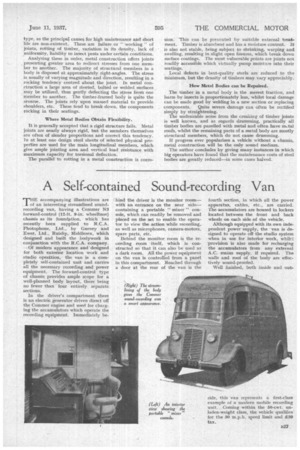The Case for the Metal Body
Page 42

Page 43

If you've noticed an error in this article please click here to report it so we can fix it.
nEALING with metal bus bodies, Mr. Homfra,y Da_vies Lisaid that when such an intricate assembly as a metal body is marketed sound reasons have to be produced for the advantages of such an article. The pioneers were possessed of two principal ideals, the first being increased advantages from the standpoint of safety, comfort and the ability to maintain the original appearance and comfort over Icing periods of service; the second, to offer advantages in total cost (spread over a long life) and negligible maintenance costs. That the modern metal bus body possesses such advantages to both public and operators has been conclusively proved under all working conditions.
A Reflection of Engineering Progress.
The advent of metal construction was an evolution from the timber-framed type and a natural economic sequence in engineering progress. The first practical type made its appearance about 1925 and consisted of non-ferrous-alloy rolled sections for the main framework. About 200 were built in this way, generally speaking with success. In 1929 the steel-framed bus body was evolved on scientific lines by a railway-carriage builder. Other forms have appeared, and it would be safe to say that about 4,000 metal bodies have been placed in operation during the past seven years.
The author referred to.a number of interesting reproductions of photographs showing, in a variety of instances,, how in each case the damage caused by accident had -been localized to a remarkable degree. In a bridge collision the roof was flattened throughout its length and the panels were torn almost beyond repair, whilst the 'crushinghad bent the upper-deck standards,but no damage was done elsewhere, and not one window was broken, whilst they moved freely in their' runs. In another case a bus overturned down a 'bank. The top corner of the upper saloon was slightly dented, and only a few cases of minor shocks and scratches occurred among the passengers. Only one rivet was broken, but three main pillars were bent, and they were easily replaced. The body was slightly out of square, but was brought to normal by removing' one roof crossmember. As a comparison, a timber body collided with a tram. The whole of the near side was dismembered, and the upper-deck panelling ripped from end to end, whilst seven passengers -were seriously injured.
Ultimate Life Determined by Obsolescence.
The steel bus gives an unequalled strength-to-weight ratio, and the life should be anything from 10 to 20 years.
In fact, the ultimate end will be obsolescence. Maintenance charges compare favourably with those of the timber
type, as the principal causes for high maintenance and short life are non-existent. These are failure or " working " of joints, rotting of timber, variation in its density, lack of nniformity, liability to insect 'pests under certain conditions.
Analysing these in order, metal construction offers joints presenting greater area to redirect stresses from one member to another. The majority of structural members in a body is disposed at approximately right-angles. The stress is usually of varying magnitude and direction, resulting in a racking tendency centred about the joint. In metal construction a large area of riveted, bolted or welded surfaces . may be utilized, thus gently deflecting the stress from one -roeixiber to another. The timber-framed body is quite the reverse. The joints rely upon massed material to provide shoulders, etc. These tend to break down, the components rocking in their seatings.
Where Metal Bodies Obtain Flexibility.
It is generally accepted that a rigid structure fails. Metal joints are nearly always rigid, but the members themselves are often of slender proportions and correct this tendency. In at least one design steel sheets of selected physical properties are used for the main longitudinal members, which give ample jointing area and vertical load resistance with maximum capacity for torsional deflection.
The parallel to rotting in a metal constructiOn is cone Sion; This can be prevented by suitable external treatment. Timber is absorbent and has a moisture content. It is also not stable, being subject to shrinking, warping and swelling, resulting in slight open fissure-s, which break down ,Surface coatings. The most vulnerable points are joints not readily accessible which virtually pump moisture into their seatings.
. Local defects in best-quality steelsare reduced to the minimum, but the density of timbers may. vary appreciably.
How Metal Bodies can be -Repaired.
The timber in a metal body is the merest fraction, and harm by insects is proportionately less, whilst local damage can be made good by welding in a new section or replacing components.Quite severe damage can often be rectified simply by straightening.
The undesirable noise from the creaking of timber joints is well known, and as regards drumming, practically all timber bodies are panelled with metal and often have mttal roofs, whilst the remaining parts of a metal body are mostly structural members, which do not cause drumming.
If progress ever popularizes a vehicle without a chassis, metal construction will be the only sound medium.
The author concludes by giving many instances in which big operators have found that the maintenance costs of steel bodies are greatly reduced—in some cases halved:






























































































